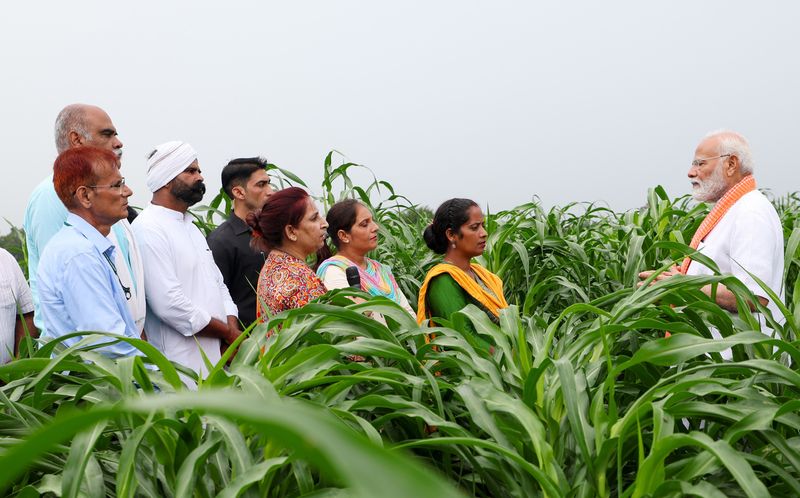Premchand’s ‘Godan’ – An iconic portrayal of farmers of India simmers in the literary memory of people. The journey of India’s ‘Annadatas’ from the hardships of the past depicted in this iconic work to the reality of today as a global agricultural powerhouse is a giant leap forward. When Russia-Ukraine conflict disrupted supply chains all over the world, India stepped up wheat exports proving its worth as a pacifying force around the globe[1]. The establishment of a dedicated Ministry of Cooperation on July 6, 2021, charts a clear roadmap for the next leap forward in agriculture, strengthening cooperatives at the grassroots.
Strengthening Agriculture Through the Ministry of Cooperation
In a country like India where agriculture employs more than 42.3% of the population of the Indian workforce[2], a Co-operative based economic development model addresses the sustainability as well as the efficiency of India’s agricultural system. Recognising its significant potential, the Government of India (GoI) has taken many steps to realise the vision of “Sahakar-se-Samriddhi”.
At the heart of India’s cooperative farming model lie the Primary Agricultural Credit Societies (PACS). By pooling resources and sharing risks, PACS enable farmers to achieve economies of scale and boost productivity.
Government has implemented numerous targeted measures in recent years to fortify PACS.
The Role of Primary Agricultural Credit Societies (PACS)
In 2023, World’s Largest Grain Storage Plan in cooperative sector[3] was rolled out as a pilot project for creation of a decentralised storage capacity and other agricultural infrastructure at PACS level. This initiative, integrating various existing schemes such as the Agriculture Infrastructure Fund (AIF), Agricultural Marketing Infrastructure Scheme (AMI), and Sub Mission on Agricultural Mechanization (SMAM), aims to develop warehouses, custom hiring centers, primary processing units, and other critical agricultural facilities.
The infrastructure developed under this project is of modern technology, increasing shelf life of perishable items and reducing post-harvest losses by creating sufficient storage capacity even up to the Panchayat/village level. It will also prevent distress sale of crops by farmers and enable them to realize better prices for their crops. Since PACS would be operating as a procurement center as well as Fair Price Shops (FPS), the cost incurred in transportation of food grains to procurement centers and again transporting the stocks back from warehouses to FPS would also be saved.
Another critical step in making PACS economically vibrant and transparent was the preparation and circulation of Model Byelaws. Developed in consultation with stakeholders, these byelaws aim to improve governance, transparency, and accountability in PACS operations.[4]
These byelaws ensure adequate representation of women and SC/ST members, making PACS more inclusive and equitable. Building on this momentum, the government also approved 1,100 additional FPOs through PACS with National Cooperative Development Corporation (NCDC) support, focusing on underserved areas where FPOs are yet to form.[5]
Modernizing and Diversifying PACS
The government has been proactive in strengthening and expanding Primary Agricultural Credit Societies (PACS) across the country. Currently, over one lakh PACS[6] are functional, and ambitious plans are in place to establish multipurpose PACS, dairy, and fisheries cooperatives over the next five years. As per National Cooperative Database, a total of 6,844 new PACS, Dairy and Fishery cooperative societies have already been registered. In addition to the traditional focus of PACS on agricultural commodities such as cereals, pulses, and dairy etc. PACS are now authorised to operate retail petrol and diesel outlets. More than 270 societies have already applied online to set up such outlets, enhancing rural employment opportunities while diversifying the income streams of PACS.
Connecting PACS with the larger goal of Digital India, the Government of India has launched a project to computerise PACS, with an allocation of over Rs. 2,500 crores. More than 25% of PACS have been integrated into ERP software, with 60% of them already going live.
This modernisation drive enables PACS to function as Common Service Centers (CSCs), offering over 300 e-services, including financial assistance and welfare schemes. These advancements not only enhance the operational efficiency and transparency of PACS but also empower marginal farmers to access government schemes and financial services more seamlessly.
PACS as a Community-Led Solution
PACS are being promoted as Pradhan Mantri Kisan Samriddhi Kendras (PMKSK), providing farmers with easy access to fertilisers, seeds, and other essential services. As per the data available over 38 lakh PACS are functioning as PMKSK[7].
Converging PM KUSUM at PACS level, these cooperatives are also facilitating the adoption of solar agricultural water pumps and photovoltaic modules, enabling farmers to embrace renewable energy solutions for irrigation and farming.
This integration of modern technologies with PACS functions underscores their role as a vital hub for enhancing agricultural productivity and sustainability in rural India.
While agriculture contributes 18.2% to India’s GDP, there is a unanimous recognition that this share must increase. However, decades of misgovernance, populist policies, and a lack of data-driven decision-making have hindered the sector’s progress. The complex nature of Indian society, coupled with the prevalence of small and marginal landholdings, has only added to the challenges. In this context, cooperative farming led with a community-led diverse, digital and resilient PACS system, emerges as the most logical and effective solution to drive growth in the agricultural sector.
References:
[1] https://www.voanews.com/a/india-steps-up-wheat-exports-amid-supply-disruptions-due-to-ukraine-crisis-/6537346.html
[2] https://pib.gov.in/PressReleasePage.aspx?PRID=2034943
[3] https://pib.gov.in/PressReleaseIframePage.aspx?PRID=1988374
[4]https://eparlib.nic.in/bitstream/123456789/2979645/1/AU2423_rtu0Gp.pdf
[5] https://eparlib.nic.in/bitstream/123456789/2979645/1/AU2423_rtu0Gp.pdf
[6]https://pib.gov.in/PressReleaseIframePage.aspx?PRID=2077945#:~:text=As%20per%20data%20available%20on,PACS%20is%20enclosed%20as%20Annexure
[7] https://eparlib.nic.in/bitstream/123456789/2979645/1/AU2423_rtu0Gp.pdf







